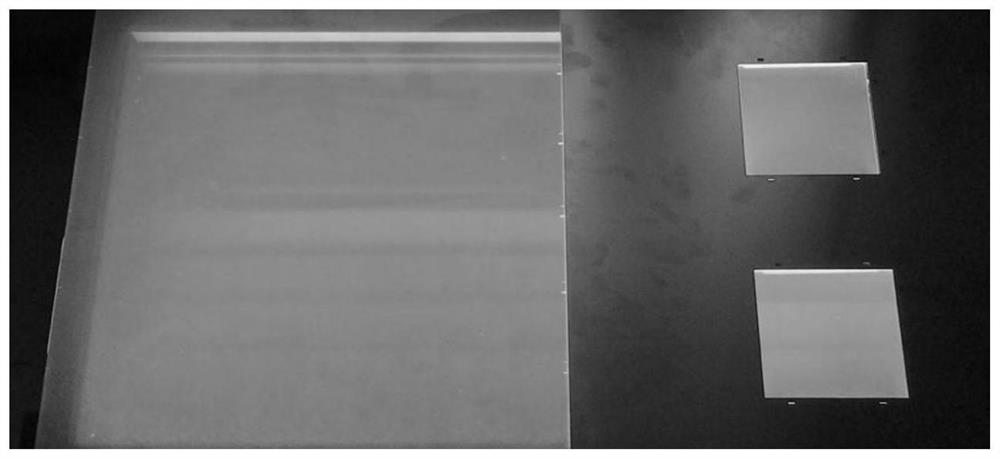Resin composition with Rayleigh scattering function and preparation method and application thereof
A resin composition and Rayleigh scattering technology, applied in the field of polymer materials, can solve the problems of sunlight exposure, no Rayleigh scattering diffusion plate preparation description, etc., and achieve the effect of easy overall solution
- Summary
- Abstract
- Description
- Claims
- Application Information
AI Technical Summary
Problems solved by technology
Method used
Image
Examples
preparation example Construction
[0062] A preparation method of a resin composition with Rayleigh scattering function, comprising the following specific steps:
[0063] (1) take raw material by mass percentage, for subsequent use;
[0064] (2) After the raw materials were uniformly mixed at 500 rpm in a high-speed mixer, the blend was fed through a hopper into a twin-screw extruder with a vent port (manufactured by Toshiba Machine Co., Ltd., "TEM-37SS", L / D=40), to form the extruder temperature conditions recorded in Table 1 and carry out melt kneading to obtain particles, that is, to obtain a resin composition with Rayleigh scattering function, wherein the vacuum of the exhaust port The negative pressure is -720mmHg, and the polymer filter uses a leaf disc filter with an absolute filtration accuracy of 10μm.
[0065] Table 1 extruder temperature condition parameters
[0066] parameter Units of measurement set value Extruder model none Toshiba TEM-37SS Barrel size mm 1500 ...
Embodiment 1-6
[0068] A resin composition with Rayleigh scattering function, the preparation method is the same as above, wherein the mass percentages and test results of each raw material component are shown in Table 2,
[0069] Table 2 embodiment 1-6 raw material ratio and detection result
[0070]
[0071]
[0072]From the data in Table 2, the results show that the increase of PC-1 and the decrease of PC / PDMS-1 are not obvious in terms of increasing light transmittance or reducing turbidity. Microscopic analysis shows that increasing PC-1 only leads to PDMS The number of domains was reduced, but did not result in a consistent reduction in PDMS domain size.
Embodiment 7-13
[0074] A resin composition with Rayleigh scattering function, the preparation method is the same as above, wherein the mass percentages and test results of each raw material component are shown in Table 3,
[0075] Table 3 embodiment 7-13 raw material ratio and detection result
[0076] Example 7 8 9 10 11 12 13 PC / PDMS-1[wt%] 30 24 18 12 6 3 PC / PDMS-2[wt%] 70 76 82 88 94 97 100 Irgafos 168 [wt%] 0.1 0.1 0.1 0.1 0.1 0.1 0.1 Siloxane [wt%] 10.2 9.4 8.5 7.7 6.8 6.4 6.0 Transmittance[%] 35 40 45 56 74 81 85 Turbidity (Haze) 99 91 76 42 10 5 3 Average PDMS domain size [nm] 39 40 38 25 25 22 18
[0077] According to the data in Table 3, the series of compositions given in Examples 7-13 have the same PC / PDMS-1 percentage content as the compositions in Table 2, but this series of compositions is replaced by PC / PDMS-2 Instead of PC-1, it can be found that replacing PC-1 with PC / PD...
PUM
| Property | Measurement | Unit |
|---|---|---|
| size | aaaaa | aaaaa |
| transmittivity | aaaaa | aaaaa |
| transmittivity | aaaaa | aaaaa |
Abstract
Description
Claims
Application Information
 Login to View More
Login to View More - Generate Ideas
- Intellectual Property
- Life Sciences
- Materials
- Tech Scout
- Unparalleled Data Quality
- Higher Quality Content
- 60% Fewer Hallucinations
Browse by: Latest US Patents, China's latest patents, Technical Efficacy Thesaurus, Application Domain, Technology Topic, Popular Technical Reports.
© 2025 PatSnap. All rights reserved.Legal|Privacy policy|Modern Slavery Act Transparency Statement|Sitemap|About US| Contact US: help@patsnap.com



